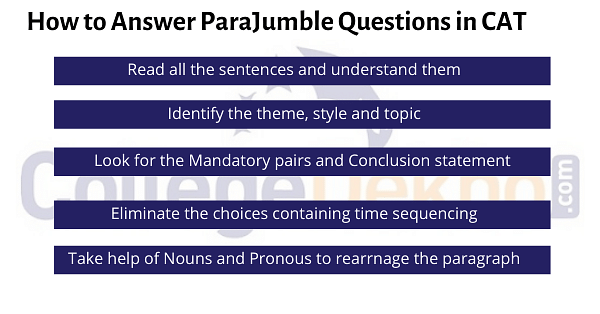Parajumble questions are easy to attempt and they can help the candidates improve their CAT 2024 exam score. Here are some important tricks and tips to answer the Parajumbles correctly in CAT 2024.
- What are Para Jumble Questions in CAT 2024?
- Tips and Tricks to Solve Para Jumble Questions in CAT …
- How to Answer Para Jumble Questions in CAT 2024?
- Types of Para Jumble Questions in CAT 2024
- Difference between MCQ Parajumbles and Non-MCQ Parajumbles
- Difficulty Level of Para Jumble Questions in CAT 2024
- Faqs

How to solve para jumble questions in CAT 2024 is one of the most common concerns of students preparing for the exam. Para jumbles is one of the most important types of questions covered in the Verbal Ability section of the Common Admission Test (CAT). The topic is also called Sentence Rearrangement. Questions covered in this section are in the form of three to four sentences that the candidates will have to rearrange in order to form a meaningful paragraph.
Although para jumbles questions are a scoring part of the CAT 2024 exam, the sentences given in the question are not easy to decode and put together correctly. Candidates have to read all the sentences carefully in order to correctly answer tricky Para Jumbles. The CAT 2024 will most likely be conducted by IIM Calcutta in November. Those appearing for the exam can find all the important tricks and tips on how to solve para jumble questions in CAT 2024.
Also Read: How to Start CAT Preparation 2024 from Scratch
What are Para Jumble Questions in CAT 2024?
As explained earlier, para jumble questions or sentence arrangement questions will consist of 3-4 sentences that the candidates will have to arrange in the correct order. Until 2019, around 15% of the total questions asked in the CAT exam were para jumble questions but there was a change in percentage in the CAT 2020 due to the revised CAT exam pattern 2024. In 2024, the exam pattern of the CAT exam is expected to be the same as that of last year's. The Para Jumble questions can be asked in the MCQ format or non-MCQ format.
For Non-MCQ or TITA Questions, there will be no negative marking while for the MCQ questions, one mark will be deducted for each incorrect answer. The exam pattern of CAT 2024 is provided below.
Section Name | Total Questions | Time Allotted |
|---|---|---|
Data Interpretation & Logical Reasoning (DILR) | 20 | 40 minutes |
Quantitative Ability (QA) | 22 | 40 minutes |
Verbal Ability and Reading Comprehension (VARC) | 24 | 40 minutes |
Total | 66 | 120 minutes |
Also Read:
| CAT 2024 Best Books |
Tips and Tricks to Solve Para Jumble Questions in CAT 2024
Before starting to solve para jumbles in the CAT exam 2024, candidates are advised to read the sentences carefully. After that, they can follow the tips provided below to answer the questions correctly.
Tip #1: Identify the Purpose of the Passage
Candidates should try to find out the purpose of the passage. Different types of purposes of para jumble questions are as follows.
- Solution-Oriented: These types of paragraphs will first explain the problem or issue and then move to the possible solutions
- Explain: These types of paragraphs will first present a general approach to some concept and then move on to the presentation of the idea. It will then be followed by the specific aspects in the following sentences.
- Surprise / Amaze: These types of paragraphs aim to create wonder or amazement among the readers.
- Anxiety / Concern: The paragraphs concentrate on the problem or issue in a way that increases the reader's concern, and then describe the features of the issue that are the reasons for the concern or anxiety.
- Aware: These types of paragraphs first make you aware of the facts and situations. These questions will first provide you with the background information before proceeding to the key issue and topic to be discussed.
Tip #2: Check the Indicators/ Keywords
Candidates can look for indicators and keywords to join their sentences. Some of the common indicators are listed below.
Introduction – A, Nowadays, An, Beginning.
Comparison Indicators – Likewise, Similarly.
Conclusion – Clearly, Thus, Eventually, Therefore, Finally.
Additional Information Indicators – Also, Additionally
Cause and Effect – Due to, as, since
Contrast Indicators – On the one hand, But, Yet, However, Nevertheless, Although.
Sequence Indicators – Firstly, Secondly, Thirdly, Lastly.
Tip #3: Form Mandatory Pairs
Candidates can also form mandatory pairs to arrange the sentences in the correct order. Mandatory pairs are basically a combination of two or more sentences that are obvious to come one after the other. These pairs will help you get rid of some of the options provided in the questions. Candidates can join the mandatory pairs and then apply permutations and combinations for the rest of the choices.
Tip #4: Use Time Sequencing
Some of the sentences contain keywords or indicators that provide an idea about the sequence of the event. Candidates can utilize these kinds of keywords to find out the correct sequence of the sentence. Some of the time sequencing keywords are “later, earlier, and then”.
Tip #5: Identify the Opening Sentence
Candidates should focus on identifying the opening or starting sentence. An opening sentence can be an independent sentence that introduces something. An opening sentence would never start with “ but, however, nevertheless, and, so, moreover, and conclusive words”
Tip #6: Take help of Pronouns, Nouns, and Antecedents
Apart from the time sequencing keywords, candidates can take the help of the nouns, pronouns, and antecedents to rearrange the sentences. For example, a sentence containing the pronoun “he, her, and his” is obvious to come after the sentence containing a noun (name).
Also Read: IIM Cutoff 2024
How to Answer Para Jumble Questions in CAT 2024?
Candidates can follow the approach provided below to answer the para jumble questions in the CAT exam 2024.
Read all the sentences and understand the meaning of the sentences
- Identify the theme and topic. Some of the common themes of these kinds of questions are Politics, Literature, and Education
- Analyze the logical flow of ideas between the sentences. Sentences should flow smoothly from one to the next, with each sentence logically following the previous one.
- Look for a sentence that can serve as the opening sentence. It often introduces the main topic or provides context for the paragraph. Opening sentences might contain general statements, background information, or definitions.
Identify the style (manner of writing) and tone (the emotional aspect of the paragraph)
Look for the mandatory pairs, Conclusion statement, linking words, and Introductory statement
Elimite the options containing mandatory pairs, time sequencing, and Introductory statement
Complete the paragraph with all the permutations and combinations

Also Read:How to Approach CAT 2024 Question Paper?
Types of Para Jumble Questions in CAT 2024
Candidates are advised to solve the question paper provided here to get an idea about the types of para-jumble questions included in the CAT 2024 syllabus. They can also download the PDF provided here:
Difference between MCQ Parajumbles and Non-MCQ Parajumbles
As we know, para jumbles questions in the CAT 2024 exam can be either in the TITA format or in the non-TITA/MCQ format. The major difference between non-MCQ parajumbles and MCQ-based parajumbles during the CAT exam 2024 is the amount of time it will take the candidate to find the correct response. The time taken by candidates will vary considerably in each circumstance. When options are provided, test-takers are more likely to pick the correct response in less time.
However, the entire process of finding the correct response may be time-consuming and tedious if the correct sequence is required to be entered. During such a situation, CAT 2024 exam candidates should keep calm and not panic if they feel like they are stuck on a particular question.
When options are provided in a CAT 2024 para jumbles question, it is possible to use them strategically to first establish the correct sequence before removing the incorrect response. When the options aren't provided, the test-taker must choose from the provided sentences the one that will probably begin the paragraph, followed by the one that will probably continue the idea, and so on until he has finally come up with the correct order.
The likelihood is that candidates will find the correct answer during the process if the question is simple, but if the question is difficult, candidates may unknowingly waste valuable time, something that is quite common when engrossed in solving a complex question during the CAT exam 2024. One of the strangest things that occur during the actual exam is that candidates often don't know they've lost a lot of time until they check the timer.
Also Read:Important Topics for CAT 2024
Difficulty Level of Para Jumble Questions in CAT 2024
The difficulty level of the para jumble questions covered in the CAT exam is moderate. Candidates might face confusion between two or three choices while answering a question. They are advised to solve a maximum number of CAT 2024 mock tests and CAT previous years' question papers to practise these types of questions. They can also consult the previous years’ toppers and experts to know the tips and strategies to attempt para jumble questions in the CAT exam 2024. The articles provided below will help the candidates to know some tips and strategies for the CAT 2024 exam.
CAT 2024 Study Plan for Students in Final Year of Graduation | |
Candidates must note that, as per the updated exam pattern of CAT, they will get only 40 minutes to answer each section. They are thus advised to divide their time accordingly.
They can spend 20-25 minutes on reading comprehension and 15-20 minutes on Non-MCQs or TITA questions. Solving the mock test papers of CAT will help the candidates to get an idea about the total time they should allocate to each type of question.
All the candidates are advised to carry their CAT admit card 2024 along with them while going for the exam. Once the exam is over and the CAT 2024 answer key is out, you can use the CAT 2024 percentile predictor to get an idea of your score. Soon after the declaration of CAT result 2024, you can also refer to the CAT 2024 college predictor to know which colleges you can get admission to.
Related Articles:
Any candidate who has any doubt or query regarding the CAT exam may clear his doubts on the Collegdekho QnA zone. For admission-related queries, fill out our Common Application Form. We wish you all the best for the CAT 2024 examination!

















Similar Articles
Best Time to Start Preparing for CAT 2024
Types of Reading Comprehension Questions in CAT 2024: Sectional Analysis and Tips
Section-wise Time Management Tips for CAT 2024
Toppers Tips for CAT 2024: Check How Toppers Prepare for CAT, Strategy & Study Tips to Score 99 Percentile
Coaching Vs Self Study for CAT 2024: Which is Better?
AP ICET Rank Wise Colleges List 2024